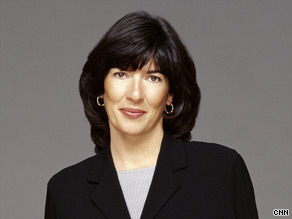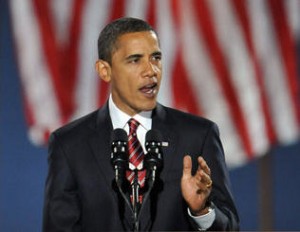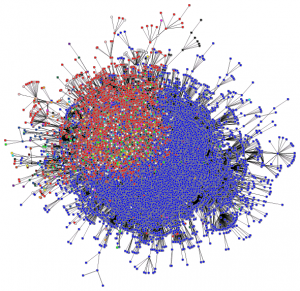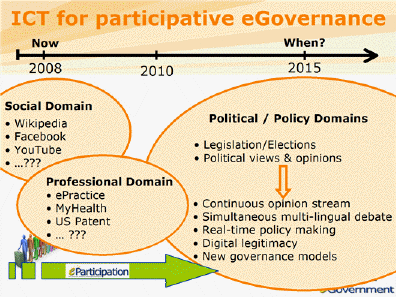Tag: Debate Map
CNN, Amanpour and Debategraph
As you may have spotted already, the collaboration between Amanpour and Debategraph launched on CNN last night, with Christiane’s new live global program featuring interviews with the Secretary General of Nato and the Prime Minister of Spain.
If you missed lat night’s episode, it’s available via Podcast here.
Debategraph’s working with Amanpour’s production team and viewers to create debate maps around the interviews and global issues addressed in the programs – and to provide a forum for non-linear, interactive and cumulative debate to complement the program’s thought-provoking analysis and interviews with the global leaders confronting those issues.
Christiane’s aims for the program “to offer multiple perspectives… and serve as the hub for a global community of inquiring minds, hungry for a more daring perspective and a strong, clear, thoughtful take on international stories” emphasize the resonance between our mutual approaches and the reason why Peter and I are delighted to be collaborating with Amanpour’s New York based production team.

“I want this show to stir the global conscience. I have witnessed so much that it’s time to start making real sense of it all”
The program airs on Monday to Thursday at 2100 CET, with a round-up of the best of the week on Fridays on CNN International and Sundays on CNN in the United States – and tonight’s show features interviews with Tony Blair, Terje Roed-Larsen (UN Middle East Envoy), Dan Meridor (Israeli Intelligence Minister), and Saeb Erakat (Chief Palestinian Negotiator).
In conjunction with the launch of program, Peter and I have released a new interface for Debategraph (which will also feature in the forthcoming WAVE climate change project for the European Commission). More on both later — but for now here’s a quick video introduction to the new Debategraph Stream interface:
Visualizing Middle East Peace
The events in Israel and Gaza this year have prompted gloomy prognoses for the prospects for peace; a mood deepened by the mixed signals from the Israeli election and the latest developments with Iran.
Lord Patten, writing for European Voice last month, struck a particularly bleak note:
"However tough things looked in the past, I have never felt such a sense of despair about Palestine and Israel. Reason has been drowned in blood. It seems as though the politics of hope have given way to the politics of the cemetery. Poor Palestine. Poor Israel."
Independent readers and the Debategraph community have started to explore the options for peace in the Middle East over the last few weeks, and, though the map is still at an early stage of development, it already provides a succinct insight into the nature and scale of the challenge; showing how strong views at either end of the spectrum pull the peace proposals towards the gyre of despair.
One of the advantages of visual mapping in this context, though, at least at the outset, is that it’s not asking anyone to take sides: just asking everyone to pool their understanding to map the contours of the problem.
The visual mapping process also opens up the possibility of creative brainstorming and lateral suggestions, such as the proposal to relocate the UN headquarters to Jerusalem, illustrated below – and we would like to see more contributions of this kind as the map develops over the coming weeks.

Given the progress made with the map so far, and the work still ahead, we’re extending the first mapping phase through the spring, and, will be including other partners in the process as we seek to engage the main actors in the region.
Anyone who would like to join us in this process is welcome to do so, and, if you would like to involve your own blog or website readers in the debate, you can embed the map—like a YouTube video—using the embed code shown below:
<iframe src=’http://debategraph.org/flash/fv_indep.aspx?r=11474&d=2&i=1′ frameborder=’0′ width=’490′ height=’650′ scrolling=’no’></iframe>
In the meantime, I will be examining different areas of the map in detail on the blog over the coming weeks and will present the mapping community’s work-in-progress to a conflict resolution forum in Haifa later this year.
Cross Posted at: Independent Minds
Mapping the Crisis in Gaza
As the What Should Obama Do Next? map began to address the unfolding events in Gaza last week, it was soon apparent that the immediate crisis and the wider Arab-Israeli conflict merited detailed consideration on a new map.
To this end, Independent readers and the Debategraph community have begun to seed a map on the crisis; including arguments raised by Robert Fisk and Johann Hari, and some of the questions and answers from the Twitter press conference organised last week by the Consulate General of Israel in New York.
The Gaza map (above)—which will require significant iteration and community input from a wide range of voices to reach maturity—is motivated by two medium-term objectives:
(1) to present the different worldviews that underpin the conflict fairly and succinctly on a common map.
(2) to map creatively and constructively the options open to the participants in the conflict and the international community, and the arguments for and against the different options.
This is an emotive subject, and the map is at an early stage of development; so if you see statements with which you disagree strongly or spot gaps in the arguments, please help us to address these on the map.
After logging-in, anyone can add new issues, positions and arguments, edit and restructure the map, and evaluate the different arguments; so the whole structure evolves as new perspectives are added to the map.
Hence, every aspect of the map at this stage should be regarded as mutable and provisional—with the aim being to enrich the structure iteratively and collaboratively until the map reflects a maximum of community intelligence.
As with the Obama map, you can also keep up to date with developments on the Gaza map via @TheIndyDebate on Twitter.
Cross posted at: Independent Minds
Towards Live Government…
The Independent’s mapping project, What Should Obama do Next? , is one of multiple initiatives appearing across the web linked to the Presidential inauguration of Barack Obama.
As Jimmy observed in his blog on the Huffington Post, mastery of internet campaigning is not the same as delivering government via the web. So it has been fascinating the observe the first edemocratic steps on Obama’s Change.gov site.
The Change.gov process so far has included blogging, YouTube insights and feedback (example below), threaded commenting, and the admirable step of opening up the content on the site via a Creative Commons license—and the volume and variety of the feedback on the discussions around health care (3,701 comments) and the economy (3,563 and counting) illustrate the potential and the challenges involved in processes of this kind.
Dan McSwain is right to note that "no other transition team has ever opened these types of channels of communication with the American people" and the team’s early energy, enthusiasm and willingness to experiment are praiseworthy; though, no doubt, like all start-up developers in public beta they’ll be attuned to thoughtful and constructive criticism as part of their process of continuous development.
Sustaining this openness to iterative experimentation will be one of the keys to fulfilling the transition team’s early promise beyond the inauguration. In part, this is because the capabilities of the web are evolving rapidly. YouTube and Twitter, for example, two of the most significant on-line tools used during the campaign, didn’t exist at the time of the last Presidential inauguration (and Twitter was only formally incorporated after Obama declared that he was running for office).
But, more fundamentally, it is because this openness to iterative and collaborative experimentation and improvement is one of the web’s deep lessons and, potentially, contains the means to transform our understanding and experience of governance.
Doc Searls refers to this wider emerging process as the "Live Web", and so, in his honour, we might characterise the opportunity ahead for the Obama transition team as being the chance to the effect significant shift towards "Live Government".
For the first time in modern industrial society, governments have the chance to realise the potential embodied in Bill Joy’s observation that there will always be more smart people outside government than within it…
And, in view of the scale and complexity of the challenges faced in the early 21st century, there has never been a more urgent time to realise this latent, distributed potential.
Live Government will take many forms that we can’t see clearly yet; however, two dimensions that seem central to the concept based on current trends are:
(1) Making the data of governance fluid, transparent, mashable and easily discoverable in context; getting the data in front of the people who have a contribution to make, and ensuring that the data is continuously up to date. This trend can be seen in the US in the form the Sunlight Foundation and the recent Apps for Democracy competition—both of which owe something to the pioneering work of the MySociety team in the UK.
(2) Externalising the current policy thinking of government in a open structured form to which people can contribute continuously, directly, precisely, cumulatively, and with a high signal-to-noise ratio. This trend, still comparatively nascent, can be seen in a prototypical form in policy wikis, annotation tools and sensemaking tools (of which Debategraph is an example).
It’s against this background that the latest development from the Obama transition team—in making all policy documents from official meetings with outside organizations publicly available for review and discussion on Change.gov—offers a tantalisingly encouraging sign.
As Dan McSwain, again, notes:
"…we’re inviting the American public to take a seat at the table and engage in a dialogue about these important issues and ideas—at the same time members of our team review these documents themselves."
It will be fascinating to see if the Obama transition team can carry this energised enthusiasm into office.

MAP UPDATE:
Thank you to everyone who has contributed to the development of the map over the last week, and to the people below for helping the map meme to circulate in the blogosphere:
Visual Mapping, Benchmarking e-gov, Tomorrow Happens, Heuristiquement, and @stoweboyd, @grisvert, @TheMindMapWatch, @jeanlucr
..and incidentally, henceforward, as well as the map email digests and RSS feed you’ll also be able to keep track of the latest developments on the map here http://twitter.com/TheIndyDebate.
Cross Posted from: Independent Minds.
Help us map the mind of the blogosphere
Cross-posted from: Independent Minds
To celebrate the launch of The Independent Minds blogs, and as part of our Obama project with The Independent newspaper, we are launching a global experiment to map the mind of the blogosphere.

Source: Matthew Hurst’s Blogosphere Meta-Core.
Not all of it, obviously… not, for example, the part that’s thinking about Britney Spears and Angelina Jolie.
We’re just focusing on the part thinking about the inauguration of the new President and the choices he faces. And we want to transfer the collective insight of the blogsophere into the map that’s already building here.
Can we do it? With your help… yes we can.

We’re not expecting you to learn the pros and cons of argument visualization; though if you want to stretch your mind with something other than a Crossword or Linkudo we’d love to help.
Instead, all you have to do, if you are blogger, is to let us know when you have posted about Obama and any of the policy issues he faces. You can do this in two ways:
(1) Include a link to the map in your blog post:
http://www.independent.co.uk/news/world/americas/article1022466.ece
or,
(2) Embed the map like a YouTube video, using the code below:
<iframe src=’http://debategraph.org/flash/fv.aspx?r=7714&d=2&i=1′ frameborder=’0′ width=’490′ height=’650′ scrolling=’no’></iframe>
Then tag the post TheIndyDebate. When you do this, we’ll detect the post and start to include your thoughts in the map.
Embedding the map will let your readers watch the map evolve in situ on your blog. And, if you link to or embed the map, we’ll publish a reciprocal link (both here and on the Independent Minds blog) back to your blog.
Starting now with: Ideal Government, Contrary Brin, AlwaystheTwain.
If we miss a blog post, email me at david AT debategraph DOT org – and if you’re not a blogger, but know someone who might interested in participating, please pass the links along.
Introducing ESSENCE 2009…

During the pre-launch phase, we are beginning to identify and assemble teams of scientists, industrialists, campaigners and policy makers to work with the tool developers on specific aspects of the complex set of issues around climate change.
The aim is to develop a comprehensive, distilled, visual map of the issues, evidence, arguments and options facing the UN Climate Change Conference in Copenhagen, that will be available for all to explore and enrich across the web.
The project is founded on principles of openness, transparency, and discovery; with no preconceptions about the conclusions that will emerge from the event.
If you are scientist, industrialist, campaigner, policy maker, tool maker—or someone with other ideas and resources to contribute—and are interested in learning more about and participating in ESSENCE, please get in touch.
Ready?… / …Engage
Essence Sponsors:


![]()
Essence Partners:



Debate Mapping Obama's VP choice…
In the wonderful way of the web, a generous invitation from Seb Schmoller to guest blog an overview post about Debategraph, led to encouraging and deeply insightful feedback from David Weinberger about Debategraph.
In a subsequent post, David called for transparent debate about Barack Obama’s choice of vice-presidential running mate, noting that:

“Barack Obama has promised to tear down the stone wall and dense bushes with which the current administration has barricaded the White House. Good. Democracy without transparency is at best assumed.
And, Obama has promised to take advantage of our new connective technology — the Internets and all its associated tubeware — to enable a level of citizen participation undreamed of since our population outgrew the local town hall.
So, how about if the campaign starts now by opening up the vice presidential selection process?”
…so here’s a debate map featuring some of the mooted VP candidates and the arguments for and against their candidacy. Anyone can add new candidates and new arguments. Anyone can rate the candidates and the arguments for and against. And anyone can embed this (automatically updating) map of the debate on their blog; so that changes made anywhere will be displayed everywhere.
Which is about as transparent as it gets.
Help us share the debate as widely as possible, and let’s find out what the collective and connective wisdom of the web makes of Obama’s potential running mates…
ICT for Governance and Policy Modelling
Thanks to David Osimo’s highly recommended blog on eGovernment 2.0, I was in Brussels at the end of last month to present our work-in-progress on Debategraph to the European Commission’s ICT for Governance and Policy Modelling Consultation Workshop Framework Programme VII.
It was a fascinating day, exploring the Information Society Directorate’s long-term research agenda in this field, against a background, outlined by David Broster Head of Unit for eGovernment and CIP Operations, of the movement of web 2.0 tools from the social and professional domain into the political and policy domains (see slide below).

Among the many excellent and thought-provoking presentations to the workshop, Anthony D. Williams’s (co-author of Wikinomics) on Wikinomics and the Future of Government and Governance, and Andy Mulholland (Global CTO of Cap Gemini) on From National Citizen to Web Citizen, had a particularly powerful resonance from my perspective.
The full set of presentations is available here.
The cluster of institutions working on interrelated projects and arriving at similar conclusions from different angles signalled strong validation for the approach that we are implementing and the goals that we are pursuing, and the enthusiasm with which Debategraph was greeted on the day was tremendously encouraging and much appreciated.
The next big event on the calendar, in Lyon, 25-27 November 2008, is highly recommended to everyone with an interest in eGovernance and eParticipation in Europe.
To be, or not to be, that is the debate map
A light-hearted debate map of Hamlet’s existential dilemma in Act III Scene I, to commemorate the 444th anniversary of William Shakespeare’s birth on 23 April 1564.

Without further ado, here’s the soliloquy—the medium in which sensitive young men worked out their feelings pre-YouTube:
“To be, or not to be, that is the question;
Whether ’tis nobler in the mind to suffer
The Slings and Arrows of outrageous Fortune
Or to take arms against a sea of troubles,
And by opposing, end them. To die, to sleep;
No more; and by a sleep to say we end
The heart-ache and the thousand natural shocks
That flesh is heir to — ’tis a consummation
Devoutly to be wish’d. To die, to sleep;
To sleep, perchance to dream. Ay, there’s the rub,
For in that sleep of death what dreams may come,
When we have shuffled off this mortal coil,
Must give us pause. There’s the respect
That makes calamity of so long life,
For who would bear the whips and scorns of time,
Th’oppressor’s wrong, the proud man’s contumely,
The pangs of dispriz’d love, the law’s delay,
The insolence of office, and the spurns
That patient merit of th’unworthy takes,
When he himself might his quietus make
With a bare bodkin? who would fardels bear,
To grunt and sweat under a weary life,
But that the dread of something after death,
The undiscovered country from whose bourn
No traveller returns, puzzles the will,
And makes us rather bear those ills we have
Than fly to others that we know not of?”
…and here’s the map of Hamlet’s internal struggle (complete with the embed code for his MySpace blog):
So, how do you rate Hamlet’s arguments—does the proud man’s contumely really sting more than the pangs of dispriz’d love? Either way, I guess Valleywag has the story covered—and, at the risk of a skewed sample, what do you make of Hamlet’s conclusion?
“Thus conscience does make cowards of us all,
And thus the native hue of resolution
Is sicklied o’er with the pale cast of thought,
And enterprises of great pitch and moment
With this regard their currents turn away,
And lose the name of action.”
![Reblog this post [with Zemanta]](https://img.zemanta.com/reblog_e.png?x-id=b8616fd4-5a1c-4727-8a11-fb6a2980caf1)